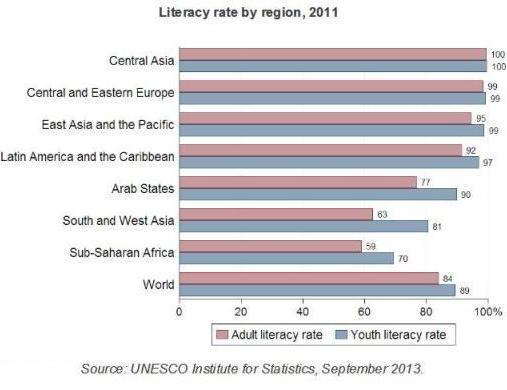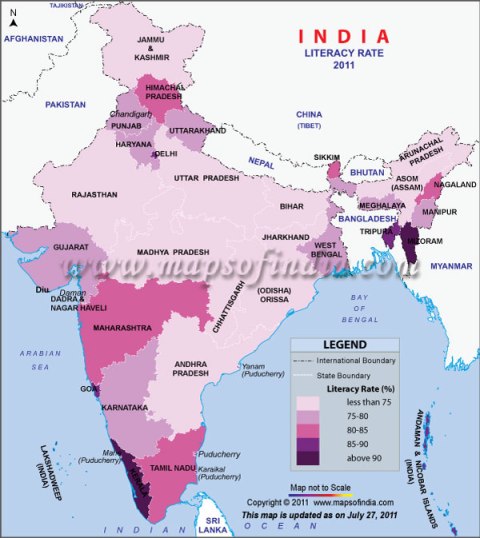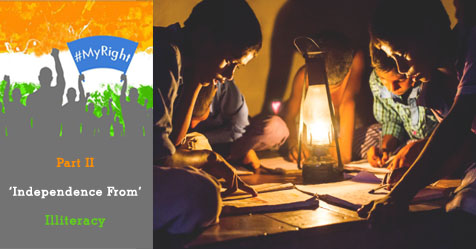In the country of Vedas, literature has always played a significant role. India boasts of a rich culture broadly based on the ancient scriptures. Unfortunately, with changing times, India cannot take pride of its literacy rates.
The literacy rate of India according to the Census report 2011 is 74.04% including 82.14% males and 65.46% females. The global literacy rate is 84.1% including 88.6% males and 79.9% females.
 Though the figures surged from 65% literacy rate in 2001 to 74% in 2011, India is far behind in the global list to achieve its target on literacy.
Though the figures surged from 65% literacy rate in 2001 to 74% in 2011, India is far behind in the global list to achieve its target on literacy.
Independence from illiteracy has been India’s vision since a long time. Many issues like unemployment, poverty, social backwardness and unrest, crime rates, suppression of women and many more are fantasised to be eradicated once we achieve literacy.
However, before dreaming big, there is dire need to understand the definition and parameters of literacy rate. India’s National Literacy Mission defines literacy as acquiring the skills of reading, writing and arithmetic and the ability to apply them to one’s day-to-day life.
The factor to ponder over is whether these parameters are enough to fetch jobs for the ‘literate’ youth, resolve their economic stress or help the socio-economic problems the country is facing. Is this parameter adequate to compete in the growing times? Is it possible to achieve the ambitious national development goals embedded with national programmes like Skill India, Make in India and others?
Lot more is needed, including raising our literacy standards. “The current literacy parameters are too shallow and thus do not provide for solutions to deep rooted socio-economic problems. There certainly needs to be proper schooling with various other factors like vocational training, skill knowledge, technological update, inclusive education, consideration of arts, science and innovation,” said Dr Narayan Iyer, Chief Executive Officer, Indian Development Foundation (IDF).
Iyer further adds, “During many of our education projects, we are posed with a common question by the beneficiaries. They ask us if they will be employable after education. We realise, only being able to read and write a language is not sufficient for employment. Many countries have taken up skill development as a part of their academic curriculum. We also need to do so or else we may have a huge human force of literate people who are not employable further keeping the socio-economic problems consistent.”
Literacy needs to be viewed not only as a measure to earn a living but also a measure to learn a living. While the world is moving ahead at a wild pace, keeping up with the speed is very essential. Not only scientific development in infrastructure is needed but fostering scientific temperament also plays a crucial role in the socio-economic growth of the country.
The existing literacy rate displays a huge gap between male literacy and female literacy- clearly speaking of the position of women in the Indian society. The inter-relation between education and society, its problems and growth opportunities need to be analysed and worked upon.

Picture: Maps Of India
Government introduced Right To Education (RTE) in 2009 and mandated private schools to give admissions to underprivileged children. What is needed however is a raise in the standard of government school education.
Among the several reasons for illiteracy, is economic inability of parents. Child labour takes place essentially because of poverty leading to absence of education in the growth years of the child’s life. Also, the quality of education in government schools adds to the drop-out rates. A holistic educational model that helps the overall shaping of a child’s future is needed in government schools too.
Corporate companies have been taking up the cause of education in different ways through their corporate social responsibility (CSR) even before the mandate came into effect. Efforts only from them will not suffice the mammoth need of education. Along with the policy changes and CSR funds, the need of the hour is individual participation in all aspects.
India has been reeling under the pressure of various socio-economic problems. Independence from illiteracy in the true sense would mean a lot to the country. “In today’s knowledge economy, literacy supplemented with employability skills play a critical role in providing access to opportunities. Mindset transformation movements which inculcate responsible youth citizenship at scale are also key to India’s holistic development,” said Prerana Langa, CEO, Yes Foundation.
A nation free from anti-social elements, citizenry conversant about the political and socio-economic choices it makes, high levels of cleanliness and low levels of diseases, 100% employment and much more would be a part of the dream where citizens are socially responsible and India is independent of illiteracy.
Thank you for reading the story until the very end. We appreciate the time you have given us. In addition, your thoughts and inputs will genuinely make a difference to us. Please do drop in a line and help us do better.
Regards,
The CSR Journal Team


